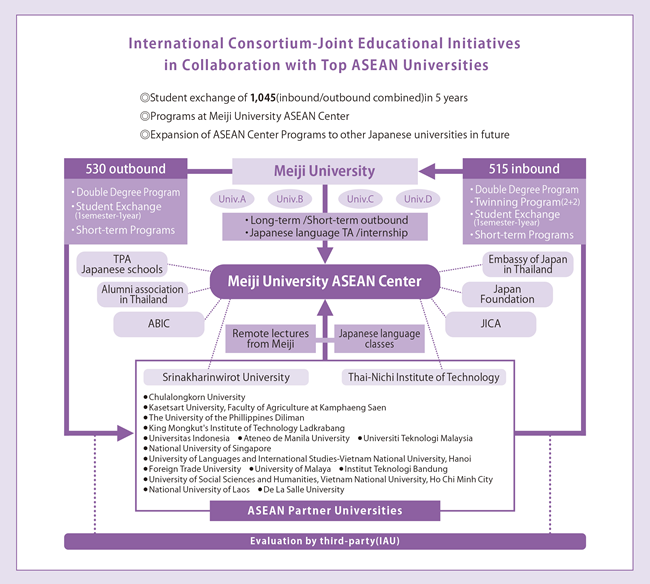Program Objective / Program Overview / Activities / Program Purpose
Program Objective
Developing Active Leaders with ASEAN-Japan Literacy

This program is to develop, in both Japan and ASEAN countries, active leaders with empowerment in practice who can become cultural bridges between the nations in fields such as business, journalism, architecture, NGOs, government sectors, and other fields.
Program Overview
Joint Educational Initiatives Collaborating with Top ASEAN Universities at the Meiji University ASEAN Center
In order to achieve the program objective, the Meiji University ASEAN Center (MAC) was set up in Bangkok, Thailand. With MAC as a hub, we established a consortium with top ASEAN universities, which enables us to implement various short- and long-term programs with the member universities. Until 2016 the program plans to provide student-exchange opportunities to 1,045 students.
Activities
Fostering ASEAN-Japan Literacy and Practical Competence

The following activities will be undertaken in the program for students to acquire ASEAN-Japan literacy:
- Providing opportunities to directly experience the language, culture, and social systems of different countries through student exchanges
- Hosting joint seminars with students of Meiji University and the consortium member universities in ASEAN countries
- Offering new classes to foster ASEAN-Japan literacy
- Encouraging Japanese students to take classes to learn Thai and other Southeast Asian languages
- Offering Japanese language education at MAC to ASEAN students before they visit to study in Japan
Furthermore, the program offers learning opportunities at MAC to both Japanese and ASEAN students as well as internships in cooperation with private companies or NGOs. Through these activities, students are expected to develop their skills of solving problems, building.
Program Purpose
Project for developing a new style of study abroad between Japan and ASEAN countries
European and American universities have actively established international branch campuses in Asian countries, offering students in host countries the education of these countries’ standards so they can become cultural bridges between two countries without actually studying abroad. This program follows the global trend and recreates the style of study abroad between Japan and Asian countries.
